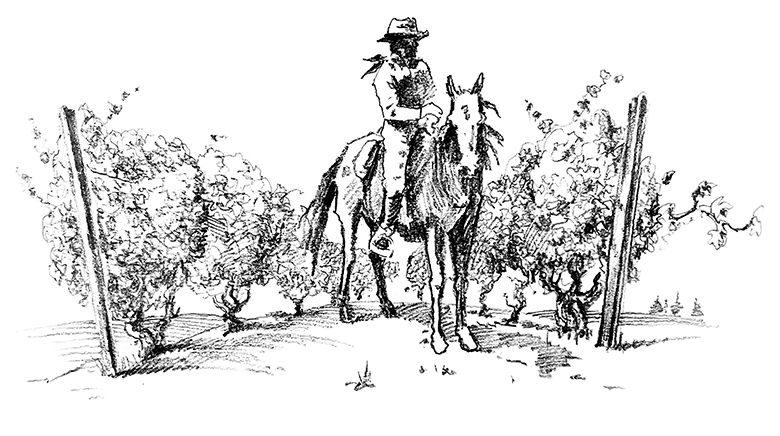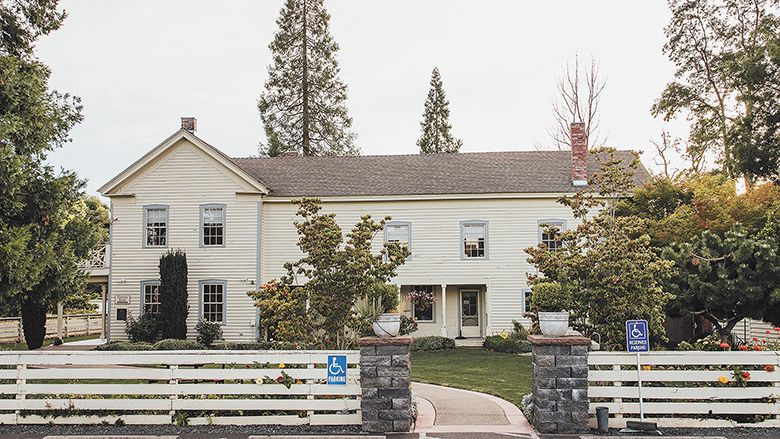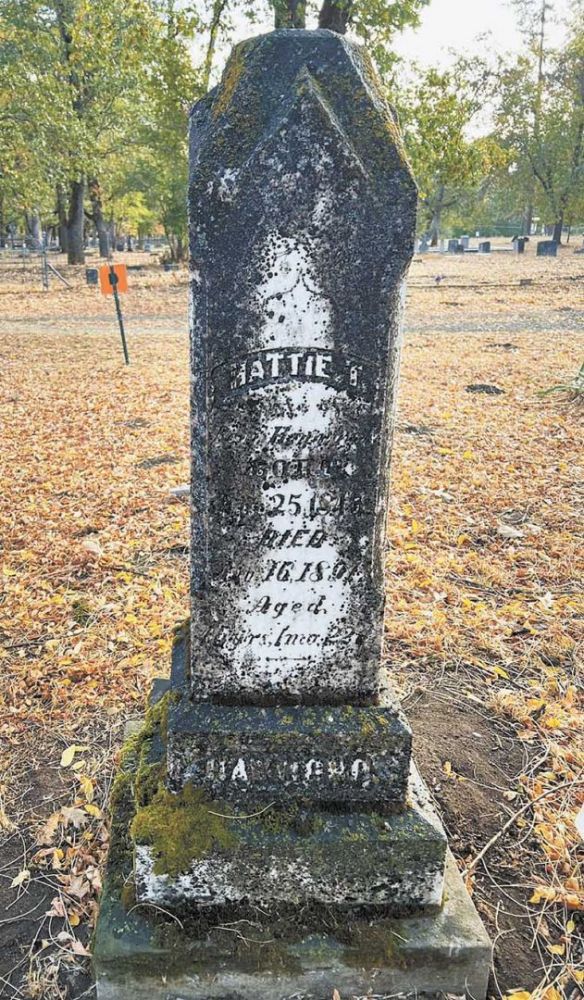Phantom Pours
Oregon Wine’s Ghostly Legends








By Greg Norton
I had no intention of alarming you unnecessarily — but you should use all proper caution. A draught of this Medoc will defend us from the damps.”
The wine sparkled in his eyes ... My own fancy grew warm with the Medoc. We had passed through walls of piled bones, with casks and puncheons intermingling, into the inmost recesses of the catacombs ...
Far too late does Fortunato, the satirically named victim in Edgar Allan Poe’s “The Cask of Amontillado,” realize an invitation to evaluate a fine sherry in a catacomb-turned-wine cellar turns to a ruse leading to his own entombment.
Sometimes, wine resembles spooky stuff. It ferments in haunted environs, swirling amid stories of sinister deaths and unexplained phenomena.
The ancient Greeks used libations to appease gods, spirits and the dead, including pouring wine on the ground during religious rituals.
Eastern European folklore believed sprinkling wine on a vampire’s grave would prevent it from rising again. Staking, burning or burying the body with symbolic talismen was also thought to stop the undead from returning to life.
In medieval Europe, wine’s sacred, symbolic associations led to the belief in its protective powers against malevolent forces, including witchcraft. Polish people added various herbs to the wine to intensify the effect.
Modern wine brands have adopted various dark and eerie monikers, including Hollywood-based Vampire Vineyards. Their bottles, adorned with red satin-lined capes, are packaged in tiny coffins.
Oregon has its share of curious wine tales to remember this time of year. Intriguing legends revisit pioneering days of early statehood and confound modern sensibilities with accounts of the inexplicable.
The murdered miner
The phrase “Gold Rush” suggests California. But the 1850s frenzy for gold extended into Southwest Oregon, enticing young prospectors from around the world to stake claims on creeks near Jacksonville and the Applegate, Illinois and Rogue rivers. According to the Oregon History Project, the 1860 census counted several hundred miners in the area, at least half Chinese.
The most lucrative market for their gold lay nearly 300 miles away in Portland. One dark night, an unlucky prospector, making the long journey on horseback, encamped on a wooded hilltop. Asleep, the man was attacked and killed, along with his horse. The killer absconded with the gold.
People believe the miner’s ghost still wanders the spot, endlessly in a futile search for the lost treasure. A lone tree marks his hilltop resting place.
Today, the site is known as Ghost Hill, part of the Bayliss family farm and home to Ghost Hill Cellars in the Yamhill-Carlton American Viticultural Area.
The family’s stewardship of this land began in 1906 when they cleared trees and brush to begin dairy farming. Since then, they have tended everything from cows and sheep to oats, barley and clover. The wide variety of this effort is a testament to the “scary” economics of small-scale agriculture, a reality that led to the 1999 decision to plant wine grapes.
“You just kind of go with what you think will make some money or what you care about,” said Mike Bayliss, who has spent 78 years farming the property. “Something that you’re comfortable with, that you can grow or raise.”
To the delight of wine lovers, the Bayliss family is comfortable producing Pinot Noir. The fourth and fifth generations now stock their estate-grown wines in a new hospitality center. The building contains a wine-tasting room and event space with expansive views of the surrounding valley… and a haunted hilltop.
The ghost of Hattie Haymond
Opened in 1865, the Rock Point Hotel served as a commercial hub for the settlement of Rock Point, on the north bank of the Rogue River in Southern Oregon. The popular stagecoach stop supplied travelers with a place to rest and eat along the newly completed roads linking Sacramento, California and Portland. Two substantial bridges and a telegraph station added to its popularity, increasing the travel through Rock Point.
The hotel was not only a place to stay but also a general merchandise store, a social gathering place and the local post office. Later, during the “pear boom” of the early 20th century, it sheltered orchard workers. Today, the building, listed on the National Register of Historic Places, is home to Del Rio Vineyard Estate’s tasting room.
Hattie Haymond’s ghost inhabits it, too.
Hattie was the stepdaughter of John B. White, the townsite’s founder, storekeeper and first postmaster. She married Benjamin Haymond, White’s business partner and a prominent citizen who succeeded White as postmaster, served two terms as Jackson County commissioner and brought various improvements to the gold rush-era waystation.
Hattie died in June 1891 in the Haymond home adjacent to the hotel. Her obituary in Ashland’s Valley Record curiously lists no cause of death, but notes: “She was an exemplary woman, of many excellent traits of character and her death will be mourned by a large circle of friends.”
The following year, Benjamin Haymond married Rose Ann Morris.
According to Lena Freeman, Del Rio’s marketing assistant, and Lindsey Zagar, director of operations, Hattie makes her presence known to employees and tasting room guests through “disembodied voices, phantom smells, the moving of objects and ghostly apparitions.”
The women’s interest in Hattie deepened after meeting a customer related to Ralph Haymond at a winery dinner. Ralph was born two weeks before Hattie’s death, but his birth certificate lists Benjamin’s second wife, Rose, as his mother. “So we have a couple theories– either Rose is Ralph’s mother and he was born out of wedlock, or Hattie was actually Ralph’s biological mother,” Freeman said.
This confusing chronology might explain why Hattie’s ghost feels restless all these years.
All three Haymonds—Benjamin, Hattie and Rose—are interred in the Rock Point Cemetery adjacent to Del Rio’s vineyard. The winery includes the family plot in its Haunted Flight Nights and Extra Haunted Dinner each October. Here, guests can learn more about the area’s history and its haunted folklore.
Young Lena Imus
Visitors to Argyle Winery’s modern tasting house might miss the adjacent 1883 structure to the north along Highway 99W. Built as a home for the Imus family, it served as Dundee’s City Hall, eventually becoming Argyle’s first tasting room. Known as Spirit House, it now hosts winery office space and special events.
It’s also believed to be haunted by one of its original residents, Lena Elsie Imus.
Lena took her own life on Dec. 19, 1908, at age 25. According to her obituary in the Newberg Graphic, she appeared to have had much to live for, recently enrolling in a business course in Portland and having been “loved and respected by all.” Nevertheless, she poisoned herself in the family home. Apparently, a romantic disappointment made her think she had nothing to live for.
“It was a love story gone wrong,” said Cathy Martin, Argyle’s community development manager. “That’s how she ended up in the situation she was in.”
Having spent more than 25 years on staff, Martin recalls many reports of encounters with Lena. These tales include hearing the crash of (invisible) wine glasses and smelling the waft of Lena’s floral perfume. The stories predate Argyle’s use of the property, from when the house was Dundee’s City Hall. “It’s not just Argyle ... it definitely is the house,” Martin observed.
Lena has surprised visitors (and employees), like the copier repairman whose toolbox inexplicably levitated and overturned. “Interest in Lena’s story comes from many different places,” Martin said. “We field calls from the media, to the paranormals, to producers of shows like Ghost Hunters.”
She remembers after one paranormal’s 3-hour audit before announcing Lena was sitting on a couch looking out a window toward the hill where the Imus family is buried in the Dundee Pioneer Cemetery.
Martin also recalls a tasting house employee who “swore that Lena went home with her in her car.”
Lena’s lore inspired Argyle to name the old home Spirithouse. Each fall, they release their Spirit House Pinot Noir and Chardonnay. Martin observes, “She’s still here...”
A sip of mystery
Wine encapsulates so much of human existence—including what we can’t explain. Widespread cultures and practices have long associated it with mystery. The surrealist painter Salvador Dalí said, “A real connoisseur does not drink wine but tastes of its secrets.”
Tales of the supernatural echo through the rows of Oregon’s vineyards. The restless spirits of scorned women hover, and a phantom miner’s footsteps beat through the countryside. These haunted tales reflect the region’s history while promising not just a taste of fine wine but also a sip of the otherworldly.
Greg Norton is a freelance writer with a broad background in nonprofit communications and the arts. He studied journalistic writing through the UCLA Extension and has traveled to wine regions around the world. Greg is a Certified Specialist of Wine and received the Level II award from the Wine and Spirits Education Trust. When not writing about wine, he can be found pouring it in the tasting room at Campbell Lane Winery near West Linn. Read more by Greg at www.onthevine.blog.










